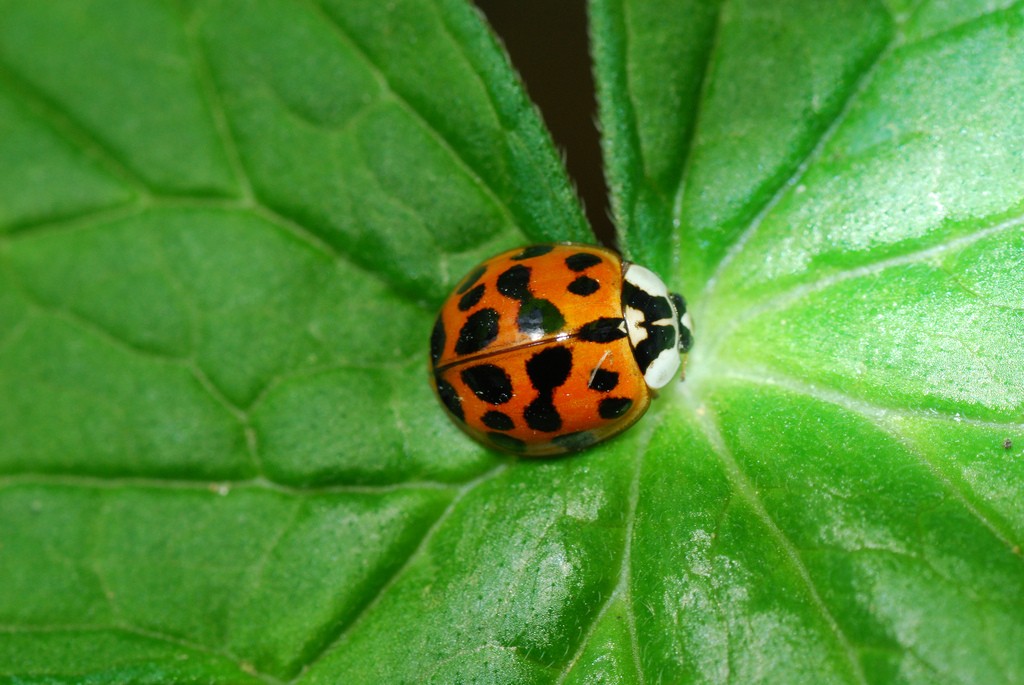A decorative but unwelcome invasive

Harmonia axyridis, the multi-colored Asian lady beetle, as you rarely see it–all by itself. Photo: Joshua Mayer, Creative Commons, some rights reserved
What’s round to oval-shaped, mostly orange, and is a common sight leading up to Halloween? Everyone knows the answer to that: Harmonia axyridis, obviously. Better known as the multicolored Asian lady beetle, this insect is no treat when it masses by the hundreds on, and inside, homes in the fall.
Lady beetles, or lady bugs, are the darlings of small children everywhere. There are a number of native lady beetle species, which tend to be more reddish than orange, and they aren’t known to be nuisances in homes. Multicolored Asian lady beetles, however, are not as polite.
First brought to the United States in 1916 to control pests on pecan trees and other crops, the multicolored Asian lady beetle didn’t turn into an ogre until the mid-1990s. Actually there’s evidence to suggest that the current population is a new strain accidentally released at the Port of New Orleans around 1993. Whatever their origin, they’re back in season each fall along with corn shocks and Jack-o’-lanterns.
Lady beetles don’t carry disease, damage structures, suck blood or sting, and they eat harmful garden pests like aphids. However, they stain surfaces, give off a foul odor when disturbed and will even pinch one’s skin on occasion. It’s their sheer numbers, though, swarming a sunny exterior wall, massed in a corner of the garage or coating the inside of a picture window, which unnerve and irritate so many people. They are most active on mild days, and may reawaken during any warm spell, even into December.
The good news is managing lady beetles will cut your heating bill. The bugs are looking for someplace warm to spend the winter, and if a draft can get in, they can too. Take some time to caulk around windows, vents, and places where cable or other utilities come through the wall. Be sure to seal between the foundation and sill. Ensure that door sweeps and thresholds are tight, and check for cracked seals around garage doors. Install screens on attic vents and inspect all window screens.
If the beetles are already indoors, don’t swat or crush them or they’ll release a smelly and staining yellow defense fluid from their joints (creepy, I know). For a variety of reasons including the lady bugs’ habit of seeking inaccessible areas, indoor pesticide use is ineffective, and is strongly discouraged. Instead, use a broom and dustpan or a vacuum cleaner. Try using a knee-high nylon stocking inserted into the hose and secured with a rubber band as a reusable “mini-bag.” Just remember to empty it as soon as the vacuum is turned off. You can also make a black light trap. Here’s how.
This fall, I think researchers should try decorating giant pumpkins to look like multicolored Asian lady beetles to see if it will frighten the actual pests away. Hopefully it won’t attract a mate of similar size. If you see a 100-pound multicolored Asian lady beetle on Halloween, please, don’t swat it.
Paul Hetzler is a horticulture and natural resources educator with Cornell Cooperative Extension of St. Lawrence County.
Tags: asian lady beetle, environment, invasive speciaes, nature








If you want to talk about an invasive species in North America, you really need to start with humans.
And now we want to start to invade other planets?